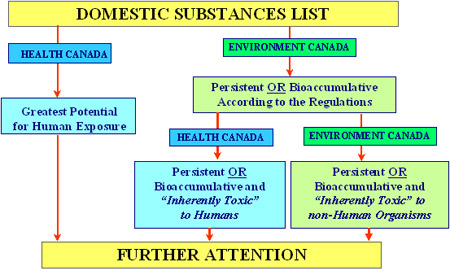Categorizing substances on the domestic substances list
Toxic substances can have different effects on human health and the environment. A substance that might be dangerous to wildlife in low levels might have no effect on people even at much higher levels. The opposite is also true: some substances can do more harm to humans than to the environment.
For this reason, Health Canada and Environment and Climate Change Canada used different but complementary criteria when sorting through the approximately 23 000 substances on the domestic substances list (DSL). This was to make sure that every substance that could potentially affect human health or our environment was evaluated to determine the need for further attention.
Environment
Persistence, bioaccumulation and inherent toxicity to the environment
Under the Canadian Environmental Protection Act 1999 (CEPA), the Existing Substances Evaluation Program is responsible for categorizing DSL substances to identify those that are suspected to be either:
- persistent (P): chemical substances that take a very long time to break down in the environment - sometimes many years. These substances can affect the environment for a long period of time. Because they last for so long, they can travel long distances and pollute a much wider area than those that break down quickly.
- bioaccumulative (B): chemical substances that can be stored in the organs, fat cells or blood of living organisms and remain for a long time. Over time, concentrations can build up and reach very high levels, and can also be transferred up the food chain.
or - inherently toxic to the environment (iTE): chemical substances that are known or suspected, through laboratory and other studies, to have a harmful effect on wildlife and the natural environment on which it depends.
Human health
Greatest potential for human exposure and inherent toxicity to humans
Under CEPA, the Existing Substances Program at Health Canada is responsible for identifying substances that have the greatest potential for exposure and are inherently toxic to humans.
- greatest potential for exposure (GPE): when assessing human exposure to chemical substances, scientists look at more than persistence and bioaccumulation. Some shorter-lived substances might affect humans just as much as persistent ones. To get the complete picture, scientists look at how a substance is used. Health Canada identified those chemical substances on the DSL to which people are expected most likely to be exposed.
- inherently toxic to humans (iTH): these are chemical substances that are known or suspected of having harmful effects on humans. Substances were examined for a number of human health effects, including cancer, birth defects and damage to genetic material.
Chemical substances that can potentially affect human health were also placed in a priority sequence so the Government of Canada can first deal with those suspected of presenting the highest hazard and greatest potential for exposure.
The categorization process that was followed by Health Canada and Environment and Climate Change Canada is illustrated in the figure below.

Description of image
Categorization of substances on the domestic substances list involves evaluation of these substances by both Health Canada and Environment and Climate Change Canada. These two departments use different criteria to identify substances on the DSL that require further attention by the Government of Canada.
Environment and Climate Change Canada is responsible for looking at all DSL substances, and determining which ones are persistent or bioaccumulative, according to the regulations. Substances that are persistent or bioaccumulative and which Environment and Climate Change Canada determines are also inherently toxic to non-human organisms are categorized as requiring further attention.
Health Canada also looks at these persistent or bioaccumulative substances, and ones that it finds are inherently toxic to humans are categorized as requiring further attention. Health Canada is also responsible for identifying substances on the DSL that present the greatest potential for human exposure, and these substances are also added to the list of categorized substances requiring further attention.
Related links
- Categorization of existing substances
- Domestic substances list: overall categorization results
- Search engine for substances